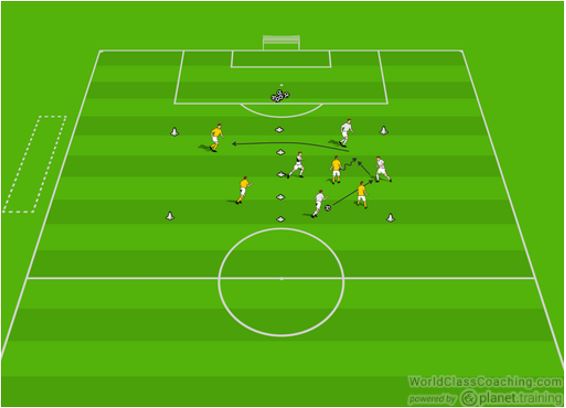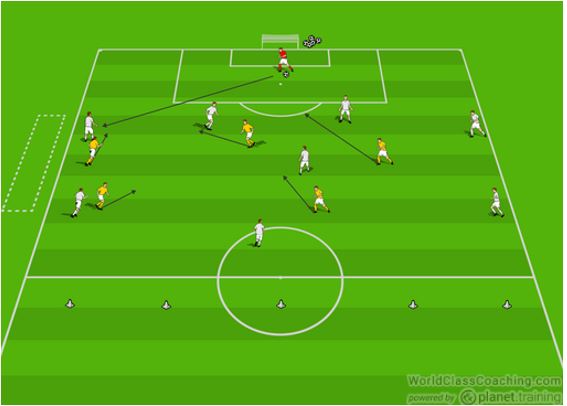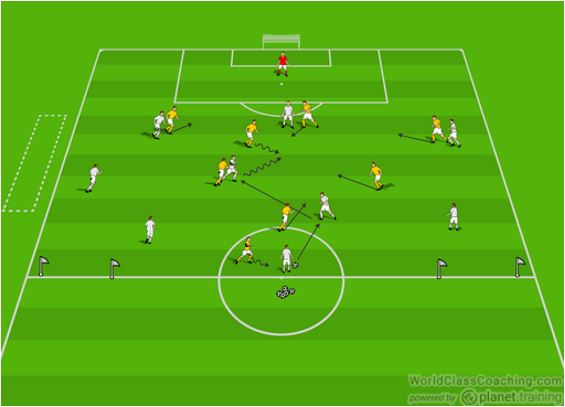By Chris Kouns
USSF A License (USSF Coaching Education Instructor) – NSCAA Premier Diploma (NSCAA Coaching Education Associate Staff Coach) – Head Women’s Soccer Coach – Georgia Gwinnett College
Assisting players in the coordinated movements and shape of their defensive unit in the 1-4-2-3-1.

4 v 2 Transition
Set-Up
Each grid will be divided into two equal sections of 15 x 20. Within each grid there will be a team of four players for a total of eight players for the activity.
Execution
One of the groups of four will send two players across to try to win the ball from the four players in possession. If they are able to win the ball they will play it back over to their side and then two of the previous players in possession will come across and defend. I recommend combining players in certain roles into your group of four. For instance you may have your double pivot (#6 and #8) with your two center backs (#4 and #5) in a group of four. This will allow the working relationship to grow between this unit.
Coaching Points
The two players defending should not go full out on every pass. Work to recognize the cues that they can get to the ball and affect the pass or possession, then go with pace.
Patience when the ball is at a players feet but close the space as the ball travels and especially should the player take a bad touch (bouncing) receive a pass that makes them face out of bounds or puts them in a spot without support.

8 v 5 + GK
Setup
You will have one big goal with a goal keeper and a counter line for the team not going to goal to cross in possession. The team going to goal will consist of a bank of five players. Again, when implementing encourage the relationship of roles and blocks of defenders such as the double pivot (#6 and #8 with the Attacking trio #7, #10 and #11). You may also want to consider setting them up in an elongated role with the #9, #7, #10, #11 and #6 in the five player unit. That block is working to stop a team of eight from possessing the ball to the counter attack line.
Execution
The back four of the block of eight should be limited to one touch. The midfield block of four (which can be deployed as a diamond, flat or box) will be limited to two touch. They will always start with the ball with a distribution from the goal keeper in the big net they are defending.
Variations
You can increase the five to a bank of seven which will give them more vertical pressure. That would mean adding a #9 and #4 to the double pivot and attacking trio.
Coaching Points
The block of five should constantly be communicating with one another as to their purpose of pressing or holding.
All of the players in that unit must be cognizant of the visual cues for them to press (i.e. balls to the sideline, balls that are dropped, balls to the GK, etc) and should be prepared to step forward quickly onto players previously identified as capable of receiving the ball easily.
While the attacking trio is actively defending the double pivot must assume positions that split their shape so that there will always be a player in the field of vision for the possessing team.

9 v 8 Attack v Defense
Setup
There will be two teams playing a regular game of soccer with one team going to a big goal and one team defending counter attack gates. The team defending the big goal will consist of eight players. This unit should include a back line of #2, #4, #5 and #3, as well as the double pivot (#6 and #8) an attacking trip member #10 and the target #9. The attacking unit can consist of any combination of nine players in a formation of your choosing.
Execution
In this activity the block of eight will be defending in their own half of the field. They must work together to not only win the ball, but, then to transition out to the attack based off their defending shape.
Coaching Points
When defending in your own end you will take fewer chances than you would when you were in the attacking third (last activity). Err on the side of caution with the top focus being not to be beaten by vertical balls.
The #9 and #10 players must be vigilant to not allow the ball to change the point of attack once it is pressed to a side. With the players behind them addressing their defensive shape based on where those players send the ball that would be devastating to their balance.
In terms of a visual point of reference for the back four and the double pivot the #5 and #3 can work with the #6 on their half of the field and then the #4 and #2 can work with the #8 on their half. This will allow for mini wolf packs to hunt the ball and force it wide of the goal.
Balls in this defensive end should be forced wide of play as it gives the goal keeper a better opportunity to see shots and crosses coming into the box as opposed to balls coming vertically at them.
By Chris Kouns: USSF A License (USSF Coaching Education Instructor) – NSCAA Premier Diploma (NSCAA Coaching Education Associate Staff Coach) – Head Coach Georgia Gwinnet College Women’s Soccer (GA)


